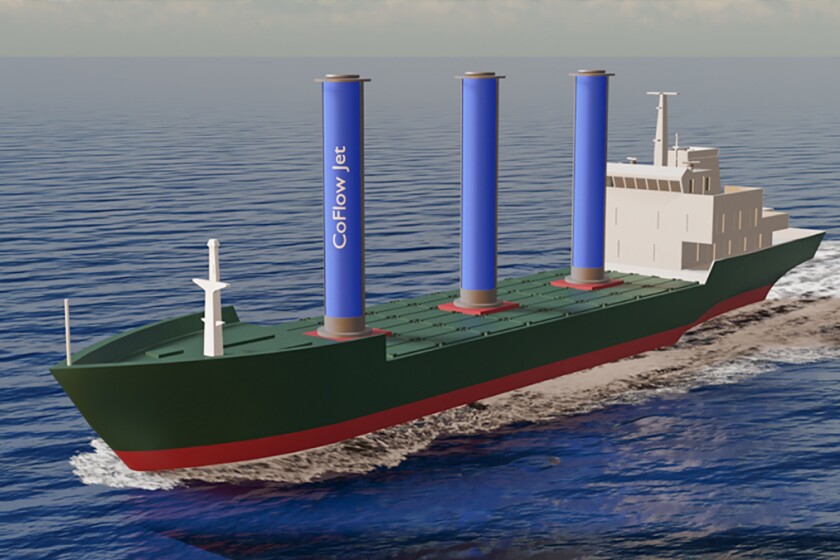Cylinder Sails May Cut Cargo Ship Fuel use by Up to 90%

CoFlow Jet
A new wind-driven system by startup CoFlow Jet, resembling a set of bridge supports mistakenly placed on a cargo ship, claims to reduce ship fuel costs by up to 90% using stationary cylinders without any moving parts.
With the dual pressures of rising fuel costs and stringent government mandates for shipping companies to achieve carbon neutrality by 2050, there’s a significant drive to enhance the efficiency of cargo ships while lowering their emissions. One approach is to revisit historical methods and reintroduce sails to harness the wind.
Challenges with Traditional Sails in Modern Shipping
At first glance, this idea seems logical. Sails have been used to propel ships globally for thousands of years and continued to be used for commercial transport until after World War II. However, two significant issues have led to their decline in the cargo market, except for very niche, local applications.
Labor Intensity of Traditional Sails
First, traditional sails require large crews. For instance, the 921-tonne tea clipper Cutty Sark needed a crew of about 30 to manage the sails and the intricate sheets and lines that controlled them. In contrast, a modern 196,000-tonne container ship requires only 13 officers and sailors, most of whom are pushing buttons rather than hauling lines.
The second issue is that sails are entirely dependent on the wind. If the wind is blowing strong enough and in the right direction, that’s great. But if it’s blowing too little, too hard, or from the wrong direction, it’s problematic. If there’s no wind at all, the ship isn’t going anywhere.
As steam and diesel power became practical, offering lower labor costs and energy on demand, shipping companies relegated sails to recreational and exploratory use.
Today, the concept of using sails is experiencing a resurgence similar to the one during the energy crisis of the 1970s, as shipping companies explore modernized versions of this old technology to cut fuel costs. Instead of vast expanses of canvas on timber masts, new systems utilize kites, composite wind vanes, inflatable structures, and even the ship’s hull as sails.
GeCheng Zha, a professor of aerospace engineering and director of the Aerodynamics and Computational Fluid Dynamics Lab at the University of Miami College of Engineering, is employing an approach inspired by the Flettner rotors developed in the 1920s but with a significant modification.
Innovation in Wind Propulsion
Flettner rotors are large rotating cylinders that create aerodynamic thrust perpendicular to the airflow over them. Zha’s CoFlow Jet cylinders, however, do not rotate. Instead, they draw in some of the air passing over and through them, then expel it from another part of the cylinder. By taking in a small amount of air, pressurizing it with an impeller, and releasing it through an outlet, this creates a pressure imbalance and generates considerable thrust along the full length of the cylinders.
According to Zha, this results in a highly effective wind propulsion system capable of providing 100% of the necessary thrust to move the ship due to its high lift coefficient and drag reduction. Unlike the Flettner system, there are no rotating parts, and it can reduce fuel consumption by up to 50% in large cargo ships and 90% in smaller ones.
While these figures might seem impressive, it’s important to remember that any sailing ship can achieve a 100% fuel reduction by setting its sails and turning off its engines, depending on wind conditions. However, another advantage of this system is that it can be retrofitted to existing vessels, and the cylinders can be retracted for easier maneuvering in and out of harbors.
“What’s old is new again,” said Zha. “With today’s technological advancements, wind-assisted propulsion is an efficient alternative to diesel engines. The major advantage is its environmental friendliness – an effective way to decarbonize the shipping industry, which is responsible for about 3% of global greenhouse gas emissions. The shipping industry has been resistant to change due to the power of diesel engines, but with increasing pressure, it will have to adapt either willingly or unwillingly.”
Read the original article on: New Atlas
Read more: Sea-Bed Air Batteries Offer Affordable, Long-Term Energy Storage










